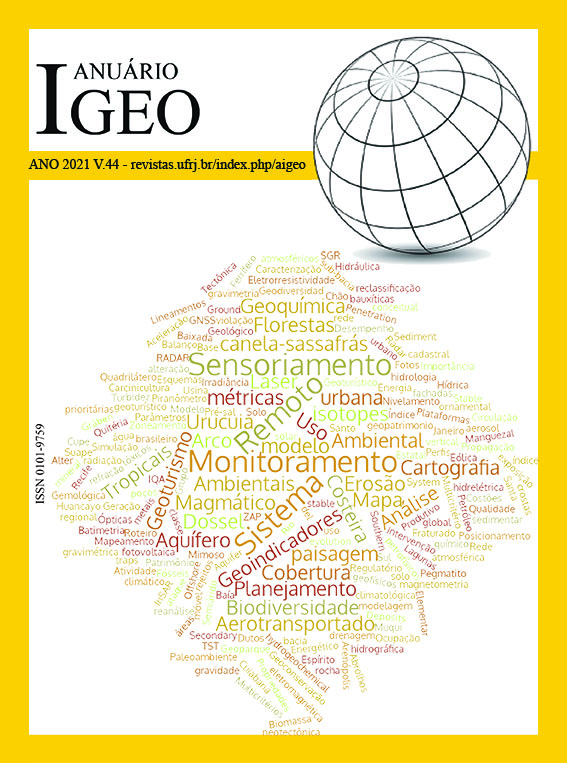Could Eremotherium laurillardi (Lund, 1842) (Megatheriidae, Xenarthra) be an Omnivore Species?
DOI:
https://doi.org/10.11137/1982-3908_2021_44_36492Keywords:
Quaternary, Carbon and nitrogen isotopes, MegatheriidaeAbstract
We present carbon (δ13Ccollagen = -10.1 ‰) and nitrogen (δ15N = 6.8 ‰) isotopic data for E. laurillardi from Brejo da Madre de Deus, Pernambuco (Brazil) and discuss the possibility of an omnivore diet for it. Our data, although ponctual, reinforce the hypothesis that E. laurillardi was a herbivore species.Downloads
References
Ambrose, S.H. 1990. Preparation and characterization of bone and tooth collagen for isotopic analysis. Journal of Archaeological Science, 17: 431–451.
Bocherens, H. & Drucker, D.G. 2013. Terrestrial Teeth and Bones. In: ELIAS, S.A. (Ed.). The Encyclopedia of Quaternary Science. Amsterdam: Elsevier. 304-314p.
Bocherens, H.; Cotte, M.; Bonini, R.; Scian, D.; Straccia, P.; Soibelzon, L. & Prevosti, F.J. 2016. Paleobiology of sabertooth cat Smilodon populator in the Pampean Region (Buenos Aires Province, Argentina) around the Last Glacial Maximum: Insights from carbon and nitrogen stable isotopes in bone collagen. Palaeogeography, Palaeoclimatology, Palaeoecology, 449: 463–474. doi: 10.1016/j.palaeo.2016.02.017
Bocherens, H.; Cotte, M.; Bonini, R.A.; Straccia, P.; Scian, D.; Soibelzon, L. & Prevosti, F.J. 2017. Isotopic insight on paleodiet of extinct Pleistocene megafaunal Xenarthrans from Argentina. Gondwana Research, 48: 7-14. doi: 10.1016/j.gr.2017.04.003.
Bocherens, H.; Fizet, M. & Mariotti, A. 1994. Diet, physiology and ecology of fossil mammals as inferred from stable carbon and nitrogen isotope biogeochemistry: Implications for Pleistocene bears. Palaeogeography, Palaeoclimatology, Palaeoecology, 107(3-4): 213-225.
Coplen, T.B. 1994. Reporting of stable hydrogen, carbon, and oxygen isotopic abundances. Pure and Applied Chemistry, 66: 273–276.
Dantas, M.A.T. 2019. Atualizando a estimativa da massa corporal da megafauna do Pleistoceno Final da Região Intertropical Brasileira. In: BOLETIM DE RESUMOS, CONGRESSO BRASILEIRO DE PALEONTOLOGIA, Uberlândia, Minas Gerais.
Dantas, M.A.T.; Cherkinsky, A.; Bocherens, H.; Drefahl, M.; Bernardes, C. & França, L.M., 2017. Isotopic paleoecology of the Pleistocene megamammals from the Brazilian Intertropical Region: Feeding ecology (δ13C), niche breadth and overlap. Quaternary Science Reviews, 170: 152-163. doi: 10.1016/j.quascirev.2017.06.030.
Dantas, M.A.T.; Cherkinsky, A.; Lessa, C.M.B.; Santos, L.V.; Cozzuol, M.A.; Omena, É.C.; Silva, J.L.L.; Sial, A.N. & Bocherens, H. 2020. Isotopic paleoecology (δ13C , δ18O) of Late Quaternary megafauna from Brazilian Intertropical Region. Revista Brasileira de Paleontologia, 23(2): 138-152. doi: 10.4072/rbp.2020.2.05
DeNiro, M.J. 1985. Postmortem preservation and alteration of in-vivo bone collagen isotope ratios in relation to palaeodietary reconstruction. Nature, 317: 806–809.
Domingo L, Prado JL, Alberdi MT. 2012. The effect of paleoecology and paleobiogeography on stable isotopes of Quaternary mammals from South America. Quaternary Science Reviews, 55: 103-113.doi: 10.1016/j.quascirev.2012.08.017
Drefahl, M. 2010. Implicações paleoambientais preliminares da análise de δ13C em osso de paleomastofauna procedente de Quijingue, Bahia. In: BOLETIM DE RESUMOS, SIMPÓSIO BRASILEIRO DE PALEOBOTÂNICA E PALINOLOGIA, Salvador, ALPP, Bahia, p. 239.
Fariña, R.A. 1996. Trophic relationships among Lujanian mammals. Evolutionary Theory, 11: 125–134.
Fariña, R.A. & Varela, L. 2018. Comment on “Isotopic insight on paleodiet of extinct Pleistocene megafaunal Xenarthrans from Argentina” by H. Bocherens, M. Cotte, R. A. Bonini, P. Straccia, D. Scian, L. Soibelzon and F. J. Prevosti, Gondwana Research, Volume 48, Issue 1, Pages 7–14. Gondwana Research, 58: 241-242. doi: 10.1016/j.gr.2018.03.004
Gaudin, T.J. 2004. Philogenetic relationships among sloths (Mammalia, Xenarthras, Tardigrada): the craniodental evidence. Zoological Journal of the Linnean Society, 140: 255-305.
Koch, P.L. & Fogel, M.L. 1997. The Effects of Sample Treatment and Diagenesis on the Isotopic Integrity of Carbonate in Biogenic Hydroxylapatite. p. 417–429.
Levins, R. 1968. Evolution in changing environments. New Jersey, Princeton University Press, IX+120p.
MacFadden, B.J. 2005. Diet and habitat of toxodont megaherbivores (Mammalia, Notoungulata) from the late Quaternary of South and Central America. Quaternary Research, 64:113–124.
Oliveira, J.F.; Asevedo, L.; Cherkinisky, A. & Dantas, M.A.T. 2020. Radiocarbon dating and integrative paleoecology (ẟ13C, stereomicrowear) of Eremotherium laurillardi (LUND, 1842) from midwest region of the Brazilian intertropical region. Journal of South American Earth Sciences, 102. 102653. doi: 10.1016/j.jsames.2020.102653
Phillips, D.L. 2012. Converting isotope values to diet composition: the use of mixing models. Journal of Mammalogy, 93(2):342–352. doi: 10.1644/11-MAMM-S-158.1
Sealy, J.; Johnson, M.; Richards, M.; Nehlich, O. 2014. Comparison of two methods of extracting bone collagen for stable carbon and nitrogen isotope analysis: comparing whole bone demineralization with gelatinization and ultrafiltration. Journal of Archaeological Science, 47: 64–69.
Smith, F.A.; Brown, J.H.; Haskell, J.P.; Alroy, J.; Charnov, E.L.; Dayan, T.; Enquist, B.J.; Ernest, S.K.M.; Hadly, E.A.; Jablonski, D.; Jones, K.E.; Kaufman, D.M.; Lyons, S.K.; Marquet, P.; Maurer, B.A.; Niklas, K.; Porter, W.; Roy, K.; Tiffney, B. & Willig, M.R. 2004. Similarity of mammalian body size across the taxonomic hierarchy and across space and time. American Naturalist, 163: 672-691.
Downloads
Published
How to Cite
Issue
Section
License
Copyright (c) 2021 Anuário do Instituto de Geociências

This work is licensed under a Creative Commons Attribution 4.0 International License.
This journal is licensed under a Creative Commons — Attribution 4.0 International — CC BY 4.0, which permits use, distribution and reproduction in any medium, provided the original work is properly cited.















